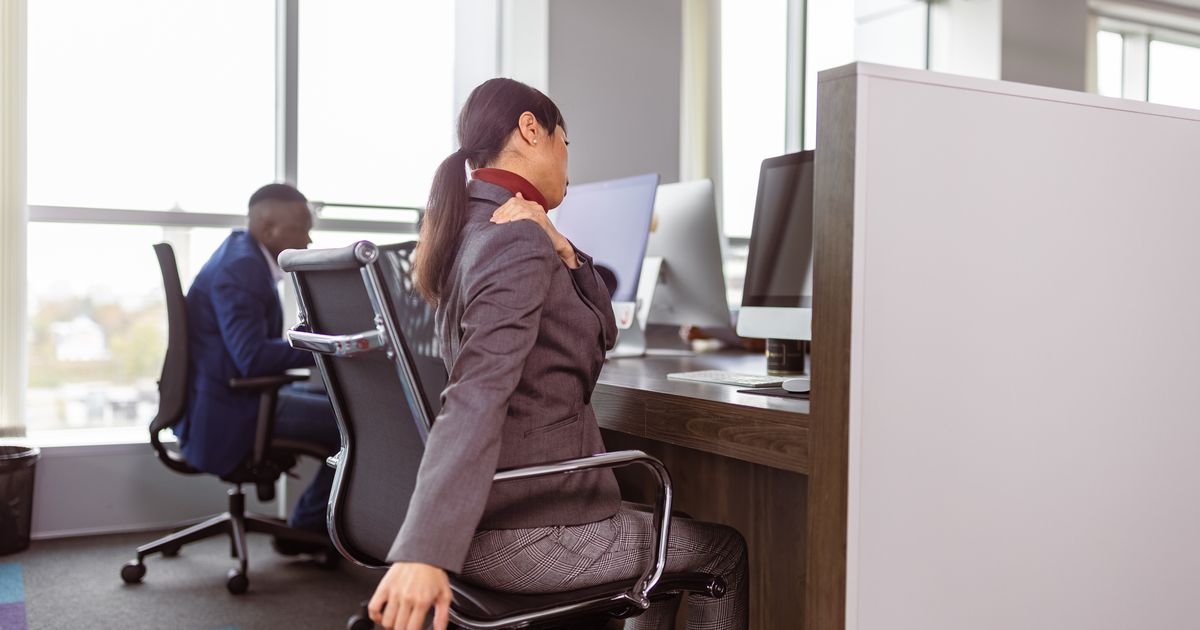Between laptops, cell phones and tablets, many people spend hundreds of hours each month hunched over and staring down at one device or another.
This kind of poor posture can lead to consequences like back pain, neck pain and even an acquired round-shouldered posture known as a dowager’s hump, said Dr. Nnaemeka Echebiri, a physiatrist at the Hospital for Special Surgery in New York.
A dowager’s hump (or hunchback, clinically known as kyphosis) is a curvature at the bottom of the neck that creates a sort of slouching posture. “It’s often due to poor posture over time,” Echebiri said.
There are many things that can lead to the development of this hunchback posture. Unfortunately, having a desk job is one of them.
But are all desk workers doomed to have a dowager’s hump in their life? Is there anything you can do to combat it? Here’s what experts say:
A huge risk factor for developing this posture is working at a computer.
Are you automatically going to develop a dowager’s hump if you work hunched over a computer screen or spend hours and hours staring down at your phone or tablet? Not necessarily, but you are at higher risk.
“Those activities in and of themselves do not lead to a dowager’s hump,” Echebiri said. But “getting used to those activities and doing them often without any postural correction exercises to offset those activities can lead overtime to that malalignment.
“If you’re not doing focused things that sort of offset that, you could find yourself liking that position more and more,” he added.
If you live a sedentary lifestyle or have poor body mechanics and poor ergonomic habits while you work, you’ll also be more likely to develop a dowager’s hump, said Dr. Kasey Komperda, an assistant professor of orthopedic surgery at the Icahn School of Medicine at Mount Sinai Hospital in New York.
Other risk factors include aging and genetics.
As we age, it’s more likely that this kind of spine curvature will happen, said Komperda, because of the loss of bone density that is common among older folks.
“In general, women tend to be at increased risk of developing osteoporosis, so that also leads to an increased risk of women developing this deformity, particularly postmenopausal women,” Komperda explained.
People with certain genetic factors (like a family history of osteoporosis) and health conditions (such as Cushing syndrome) are also at higher risk of developing a dowager’s hump, he said.
Ergonomics can protect your spine.
First, if you do work a desk job, it’s important to have an ergonomic setup, said Echebiri.
“There are a lot of ways that you can do this, but adjusting your screen height can be really important so that you’re not looking down at your screen or keyboard too often,” he said.
Instead, you should be looking straight ahead of you and maintaining a neutral posture. Consider your screen placement, keyboard placement and mouse placement, and the height of your work surface.
It’s also important to get a supportive chair, one that allows you to sit upright and ideally even has lumbar support, Echebiri added. “Then you’re not hunching over, but you’re sort of in a relaxed position with your head upright and looking straight ahead.”
miniseries via Getty Images
There are exercises that can help strengthen your spine, too.
Komperda recommends chin tucks, which is when you “literally pull your chin back, to strengthen your neck muscles,” he said. You can also do scapular squeezes “where you can squeeze your shoulder blades together,” Komperda said. He recommends three sets of 10.
Dr. Sheela Vivekanandan, a neurosurgeon at the University of Pittsburgh Medical Center, said core strength is important for reducing your risk of spine problems, too.
“Any abdominal exercises will work — just make sure to protect the back and graduate up in intensity,” she said. “I recommend anything from planks, crunches, leg lifts, bicycles, oblique crunches — just 10 minutes daily would suffice.”
Beyond strength exercises, other forms of movement can decrease your chances of developing a dowager’s hump, too.
“Every hour, making sure you look up from your screen and just take a short walk around the office or around your house — that can do wonders, for sure,” Vivekanandan said.
Dowager’s humps can cause pain and other problems, too.
Because it’s a visible issue, having a dowager’s hump can take a toll on your self esteem, Komperda noted.
They can also cause issues like neck pain, and people with humps often suffer from headaches and migraines, noted Vivekanandan. “The muscles in your neck are certainly getting strained when they’re in these positions.”
In most cases, you can reverse a dowager’s hump.
If you look in the mirror and notice a hump at the base of your neck, or notice any of the issues mentioned above, it’s a good idea to let your doctor know. They can refer you to a physical therapist — and all three experts said physical therapy can help reverse a dowager’s hump.
“A [physical] therapist can really assess their alignment and teach them exercises … dealing with postural correction, scapular stabilization, scapular retraction and elevation,” said Echebiri. And they can teach you exercises to help strengthen your spine.
For the majority of people who work a desk job, just realizing that you’re hunching over or leaning forward to see the screen is the first step, Komperda said. Once you notice, you’ll be more likely to use proper ergonomics, get the right desk equipment and focus on doing exercises that can help your strength and mobility. “We call that postural awareness,” he said.
So, you aren’t going to have a dowager’s hump just because you work a desk job. And if you’ve recently noticed you have one, you can make changes to get rid of it.
“We can safely say that this is, in most people, a reversible, and certainly preventable, condition,” Komperda said.

